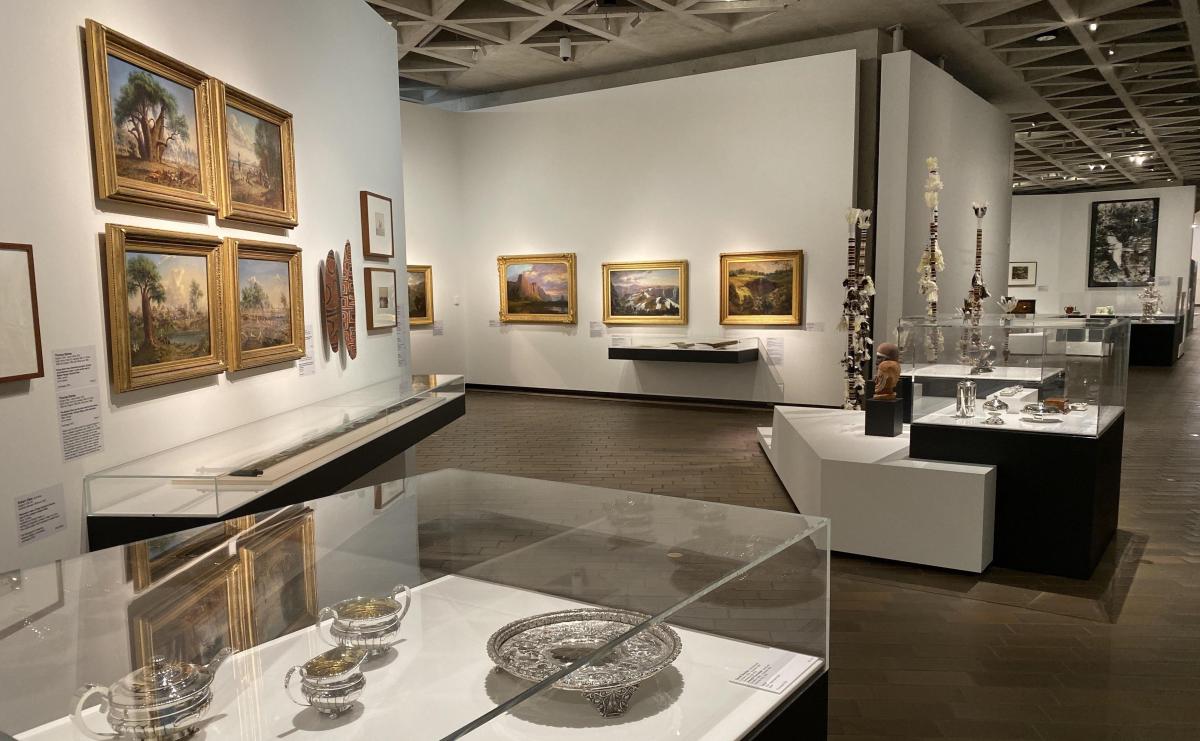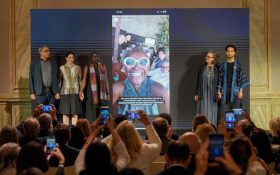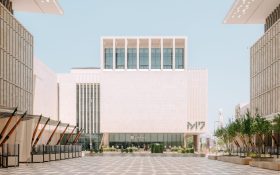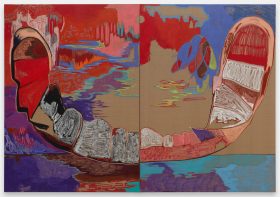The way we present the narratives of early Australian art has changed. It had to.
No longer are these museum hangs myopic colonialist views, padded out with symbols of colonial opulence – furniture, silverware, ceramics, jewellery – and the token bark painting or boomerang. Rather, they are a significant step in righting wrongs, and finding truth through greater transparency to the narratives that sit behind and beyond Australian art.
It is a movement that has been slowly sweeping across our state institutions.
What seems to be at play is a shift – a shift from a white narrative with a “patched in” Aboriginal acknowledgment, to an Aboriginal-led lens that introduces the colonial narrative into – and not over – that position.
In late December, the National Gallery of Australia (NGA) unveiled, Belonging: Stories of Australian Art, which it describes, ‘recasts the story of nineteenth-century Australian art’.
Work on the hang commenced in late 2018, and involved a curatorium of eight Indigenous and non-Indigenous curators from within the institution. Those curators were: Kelli Cole, Franchesca Cubillo, Rebecca Edwards, Emma Kindred, Shaune Lakin, Anja Loughhead, Sarina Noordhuis-Fairfax, and Anne O’Hehir.
The team described: ‘Collaboration creates and stimulates creative ways of thinking, a great way to exchange ideas and discuss collection, multiple voices, different perspectives … Our project was informed by a range of decolonising strategies. We approached the exhibition through a new set of Indigenising methodologies based on sharing, connecting and networking.’
They added: ‘Our project aimed to reflect the culture we hope to see develop across Australian institutions in which decisions are made collaboratively, and that reflect and embed a range of positions and points of view.’
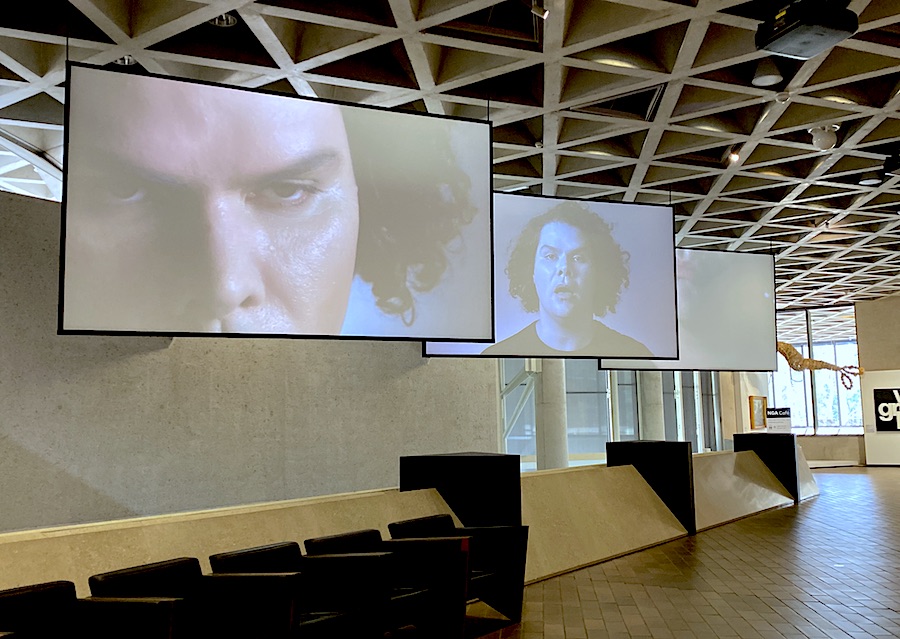
Christian Thompson, Berceuse (2007), 3-channel video. Installation view Belonging: Stories of Australian Art, National Gallery of Australia. Photo ArtsHub.
Over 170 artworks and objects tell this renewed narrative, which is introduced at the entrance to the galleries with a quote by Aboriginal activist Charles Perkins (2001): ‘We know we cannot live in the past but the past lives in us.’
The Belonging team continued Perkins’ sentiment. They told ArtsHub: ‘Collection displays at the National Gallery have traditionally privileged the point of view of settler-colonists. For example, displays of non-Indigenous art often start with the arrival of Europeans. This ignores millennia of First Nations occupation and unceded sovereignty. We worked together to ensure Belonging begins with acknowledging the Ancestors and cultural knowledge of First Nations peoples that is continuously shared through art, song, stories and ceremony.’
The exhibition draws on the Indigenous notion of Everywhen, when past, present and future exists as one. In Indigenous cultures, time is not chronological, or passing moment after moment. By embracing this foundation, the concept of Terra Nullius, or a colonial preferrencing when it comes to art history, lose traction.
Can we all “belong” in this new narrative?
Audiences are ushered into the exhibition by the 3-channel video Berceuse (2017) by Bidjara artist Christian Thompson, which is suspended high overhead like some celestial message. The “pop songs,” Thompson has written in pigeon Bidjara ensure cultural sustainability, when traditional songs no longer remain.
It is backed by a suite of powerful works that set the tone for this show: Vernon Ah Kee’s cantchant (2009) – a painting of the phrase “we grew here” in black and white, which was chanted during the Cronulla race riots of 2005; Christopher Pease’s imposing painting, Target 3 (2017) – a replica of the colonial landscape of King George’s Sound by Lieutenant Robert Dale, which is emblazoned with a target (aka prime land grab), and Daniel Boyd’s map of Australia, Treasure Island (2005), which demarcates territory by Indigenous language groups rather than colonials boarders.
There is no mincing of messages here. It is bold, it is proud, and it is a voice no longer presented as “alternative”, but rather “leading”.

Installation view Belonging: Stories of Australian Art, National Gallery of Australia. Photo ArtsHub.
Also among the first works encountered by viewers is a pair of colonial busts by Benjamin Law of Trucaninny, Wife of Woureddy and Woureddy, an Aboriginal chief of Van Dieman’s Land, both modelled from life. Despite her family being killed, Trucaninny played a crucial role in the attempted ‘conciliation’ process in Tasmania. Around her neck is an exquisitely laced maireener shell necklace. These are echoed in a museum case behind, by Tasmanian artist Lola Greeno.
The busts sit within a clustered narrative of works including Augustus Earle’s iconic Portrait of Beungaree, a native of New South Wales (c.1826) – a leader, cultural mediator and diplomat to Matthew Flinders’ expedition to circumnavigate Australia; the bark, Too many Captain Cooks (1985), by Gela Nga-Mirraitja Fordham, which tells the long story of exchange and trade with the Macassans and other foreigners to the north, Julie Dowling’s painting Walyer (2006) armed and ready to defend her lands in the south, and the contemporary photos by Ricky Maynard and Brenda L Croft which speak of Land Rights.
In just this one gallery that visitors enter through, the depth and tensions within the narrative of Australia’s early history is laid bare.
The exhibition hang is dense, and that constant layering is at play – juxtaposing narratives in the endeavour to find fresh truth in their collective presentation.
Each section of the exhibition is introduced through a theme – Songlines, Making Country, Connection to Country, and Mourning and remembering – the didactic curatorial notes for each always led with a quote by a respected Aboriginal elder.
A particular provocative section is the one dealing with Mourning and remembering. Tasmanian artist Julie Gough introduces: ‘The stories are in the gaps, the traces, the silences and apparent absences.’
The stories are in the gaps, the traces, the silences and apparent absences.
Julie Gough
The subjects of conflict, massacres and genocide are still largely untold in our museums, and yet they are an integral part of the colonial experience. The curators broach the topics of loss and trauma at a level not previously presented in a collection hang.
Walking along one of the main walls in this gallery, viewers encounter a traditional portrait by Robert Dowling of a widow mother, Jane Sceales with daughters (c1856) alongside Julie Dowling’s portrait, The nurse and maid (Biddy) (2005), an Aboriginal wet-nurse. Where is her own child?
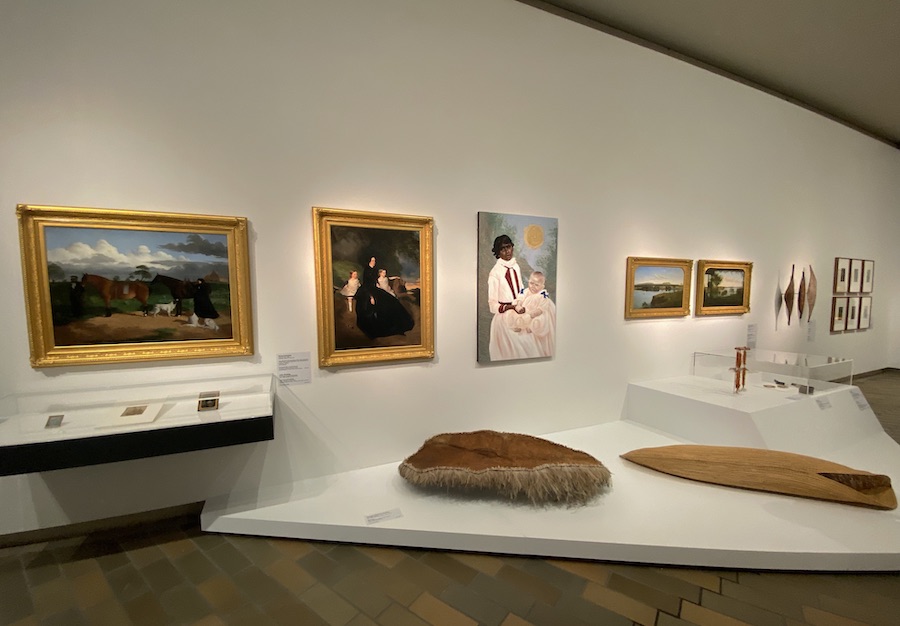
Installation view Mourning and remembering section within Belonging: Stories of Australian Art, National Gallery of Australia. Photo ArtsHub.
Below them is a Kooliman by Lorraine Connelly-Northey, which again speaks of sustenance, a Burial mat by Yvonne Koolmatrie, a mourning armlet suspected to be from Arnhem Land, and two views of Purrumbete by Eugene von Guerard (1858) – commissioned by squatters in celebration of their new properties – land claimed through the violent dispossession of Aboriginal communities.
Completing the run is a suite of Ancestral shields (for battle) and a group of photographs by Michael Riley from the Sacrifice series (1992), which point to the role of Christian missions in the displacement of Aboriginal communities.
Viewers are ushered into a broader reading of history, and are encouraged to find their own understanding of the present, through the past.
The section Making Country is a further interesting juxtaposition of thinking. Colonialists place-making, aka clearing the land and crafting furniture and wares and paintings in a European style as decoration, sit in contrast with the way that Aboriginal people negotiate the landscape as a physical and cultural space for ancestral memory – one where they are perpetual custodians.
Through the very placement of objects and artworks alongside each other, benign of hierarchy for the first time, each can be appreciated for their aesthetic richness and their contribution to our complex national narrative.
Furthermore, the curators have used the architecture to create portals for conversation – almost cabinet of curiosities to use a Victorian genre – but have turned that voyeuristic eye upon the “exotic” to one that is similarly handled with equal weighting – European jewels, hair combs, daguerreotype photographs, just as much an expression of “otherness”.
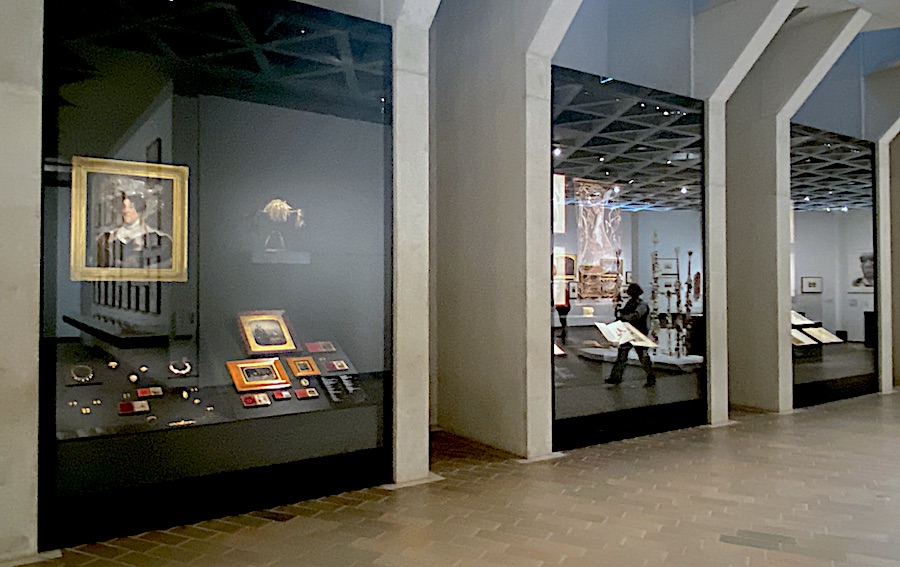
Installation view Belonging: Stories of Australian Art, National Gallery of Australia. Photo ArtsHub.
This is not a rehang; it’s a rewriting of Australian art
In October 2017, the Queensland Art Gallery (QAG) unveiled its rehang of the Australian galleries. The space had been closed 16 months in preparation for the new hang.
Director Chris Saines told ArtsHub at the time. ‘We have presented a very exciting rethinking of the way in which we interweave and interlock the stories of Indigenous Australian art history and non-Indigenous or post colonialisation history in a way that, I will claim, has not been told in any state or national institution in Australia.’
The collection is a little broader than NGA’s finely tuned read on history, extending it into a contemporary conversation.
Similarly, in early December 2018, the Art Gallery of South Australia (AGSA) also unveiled a renewed display of its Australian Art in the gallery’s Elder Wing with its weighty Victorian architecture – a hang overseen by Australian art curators Tracey Lock and Elle Freak.
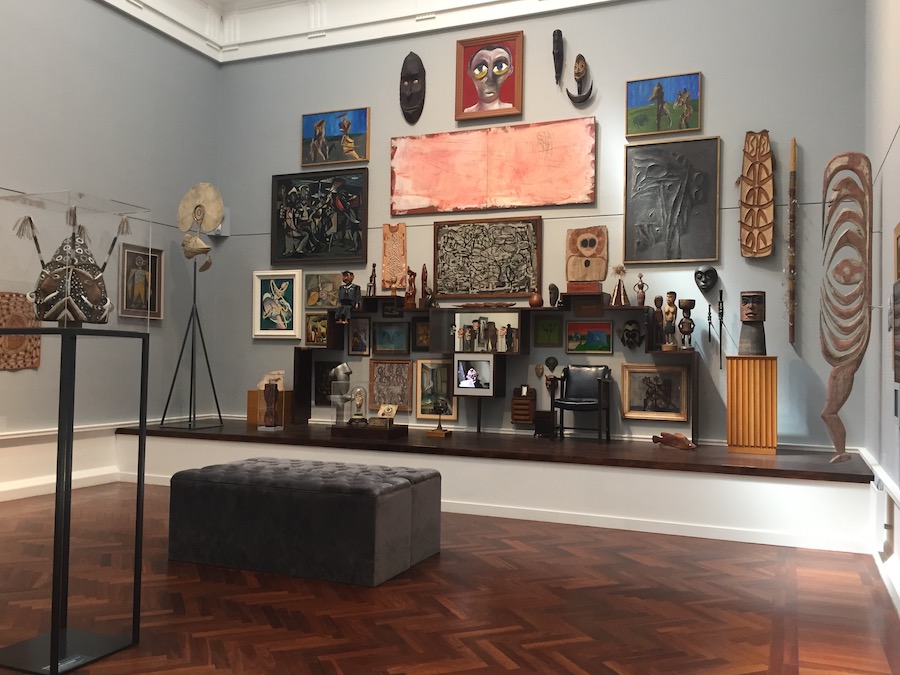
Installation detail view of Elder Wing, Art Gallery of South Australia. Photo ArtsHub.
Like both the NGA and QAG, it has taken a cross-disciplinary approach, what Director Rhana Devenport has described as an ‘ahistorical and transnational display.’ This “shake up” was really started under Nick Mitzevich and his team when at AGSA (now director of NGA), when the parallel Melrose Wing was rehung in a salon style, playing off the cabinet of curiosities.
With around 800 works on show, AGSA’s Elder Wing has a very feel to the NGA’s hang – both behoven to their tone of their architecture. And yet they both shake up the narrative.
For example, in a room under the theme Infinite Journeys, the lesser known story of the depiction of cameleers in Australian art pairs Nicholas Chevalier’s painting of Burke and Wills and their camels and a watercolour by Albert Namatjira, who worked as a cameleer, which includes the Arabic salutation salam carved into a red gum.
Clearly, all galleries are in agreement here. Objects need to constantly be reconsidered, both in terms of the context in the past, and their context in the present. ‘They are never fixed in time,’ adds Devenport.
The difference is the NGA– as the National collecting institution – has surprisingly not turned from taking a political stance. It is bold, and it offers a pathway forward.
